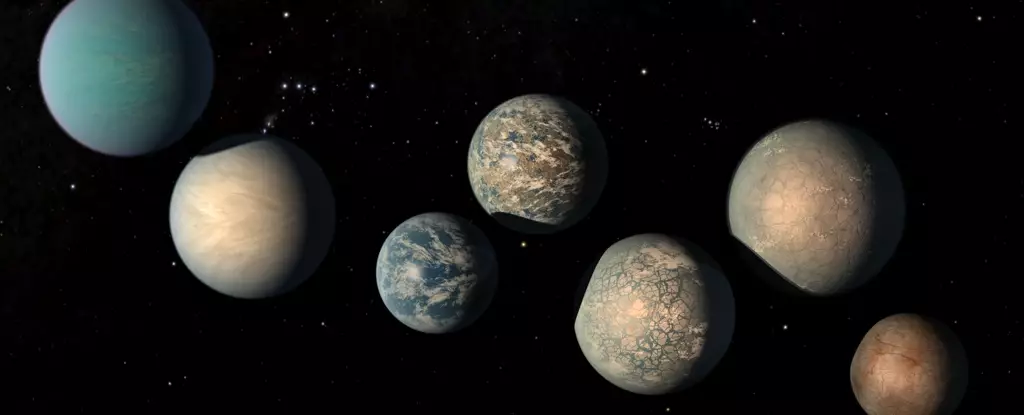In the astronomical chronicles of recent years, few discoveries have instigated as much intrigue as the TRAPPIST-1 system. Located roughly 40 light-years away, this unique assembly of seven planets, all orbiting a temperamental red dwarf star, has become a focal point in the quest for extraterrestrial life. Since their initial discovery in February 2017, astronomical research and public imagination alike have been captivated by the possibility that these planets could harbor life-sustaining elements, particularly water. New research suggests that these celestial bodies might brim with water, challenging our understanding of habitability in harsh environments.
Astronomers face a complex tapestry of variables influencing the habitability of these planets. The architectural design of the TRAPPIST-1 system, with its tight knit of planets close to their host star, raises serious discussions about the effects of stellar flares and radiation. M-type stars, such as the one at the center of this system, are smaller and cooler than our Sun, but they are notorious for violent outbursts that can significantly impact atmospheric integrity. This volatile environment raises pressing questions: Can these planets sustain their atmospheres in such harsh conditions? Is water present in a form that can support life as we know it?
Water: The Double-Edged Sword of Habitability
The presence of water remains a critical litmus test for assessing planetary habitability. For years, scientists have debated whether red dwarf star systems like TRAPPIST-1’s could effectively retain water amidst intense stellar activity. Early theories indicated that while an overabundance of water might exist, it might be lost to the relentless UV radiation emitted by the host star. This paradox of water availability has left astronomers to sift through the data for signs of water’s presence on these distant worlds.
Recent findings, spearheaded by Trent Thomas and his team from the University of Washington, have delivered new insights. Their work symbolizes a convergence of observational astronomy from the James Webb Space Telescope (JWST) and complex modeling techniques that reflect conditions on terrestrial planets in our Solar System. Their research suggests that not all planets in the TRAPPIST-1 system are doomed to a static, desolate fate. Instead, they unveil the possibility that water vapor may still exist, potentially linked to geological processes such as volcanic outgassing, despite observations indicating a lack of a thick carbon dioxide atmosphere reminiscent of Venus.
In their modeling, the researchers sought to quantify the outgassing rates, drawing parallels with the rocky planets within our own Solar System — Mercury, Venus, Earth, and Mars. Their findings suggest that all seven planets are capable of outgassing at rates anywhere from 0.03 to eight times that of Earth. However, the results cast a shadow of uncertainty regarding the degree of volcanic activity within these distant worlds, revealing that they might share more with a quiescent Mars than a vibrant Earth.
Sculpting a New Perspective on Habitability
What is truly arresting about their research is the implications it bears for understanding the composition of the planets’ mantles. The team theorizes that these planets could embody relatively dry Earth-like mantles, potentially containing less than 1 percent of water by mass. This revelation reframes the conventional narrative surrounding TRAPPIST-1, suggesting that habitability may not rest solely on water’s abundance in surface oceans. Instead, life could, in theory, exist in varied examples of geochemical stability, albeit under challenging conditions.
The research does not shy away from juxtaposing Earth’s vast oceanic expanse, which constitutes about 71 percent of its surface but only accounts for a mere 0.02 percent of its total mass. Such numbers sway the narrative, hinting at the potential for diverse planetary characteristics among TRAPPIST-1’s exoplanets, ranging from barren rocky worlds to those that might emerge as water-rich environments.
However, the TRAPPIST-1 story is far from complete. The ongoing observations by JWST and future missions carry promises of deeper insights into these fascinating worlds. There are numerous questions yet to unravel about their atmospheres, compositions, and whether they harbor conditions conducive to life.
The Road Ahead: How Will We Unravel the Mysteries of TRAPPIST-1?
In closing, the Rich tapestry that is the TRAPPIST-1 system encapsulates an awe-inspiring exploration of the cosmos. It challenges prevailing notions of habitability and underscores the complexity of alien environments. The interplay of water, volcanic activity, atmospheric composition, and stellar influences paints a compelling picture that beckons further investigation. As our observational technology evolves and our understanding deepens, we may soon find sustained leads toward answering one of humanity’s most profound questions: Are we alone in the universe? With every data point, TRAPPIST-1 urges us forward in a relentless pursuit of knowledge, exploring the truth hidden within the heavens.

